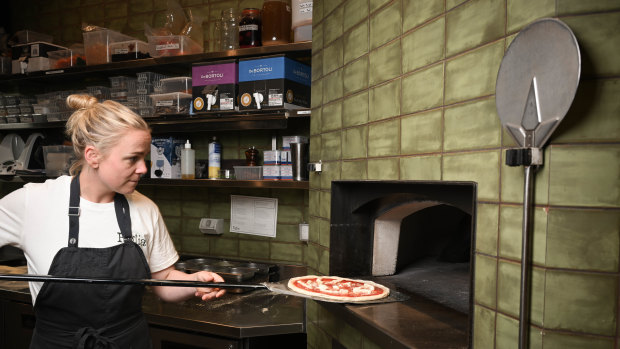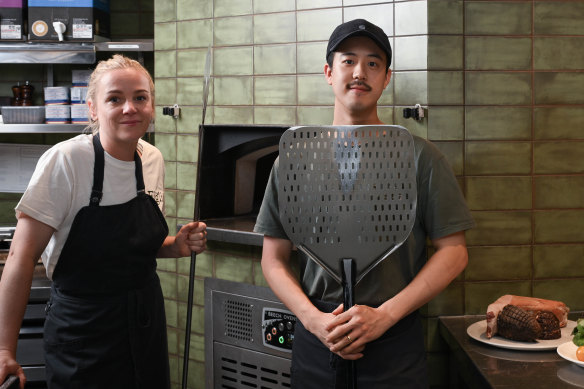
I knew it was all about the leopard spots.
For 15 years, I have been making pizza on my kitchen bench and through all the hand-kneading, experimentation and recipe fine-tuning (oh look, internet tips from the world’s best pizza chef, yes thanks!), I have made some airy discs with crisp bases. But those leopard spots – the charry, blistered bubbles that dot a great crust – have eluded me.
The two people in charge of making pizza (professionally known as “pizzaioli”) at Figlia trattoria in Melbourne’s Lygon Street confirm the spots are a sign of a well-made pizza. What have I been doing wrong?
The leopard spots are the result of three main factors: the correct flour-to-water ratio, allowing the dough enough time to rise, and preferably a naked flame, Lucy Whitlow and Junhee Han tell me when I visit them for a masterclass.

So let’s start with the basics.
You have to let your dough prove for at least 24 hours. This is one of the key points I have observed closely in my long, not very illustrious pizza-making career.
Here’s why. Yeast needs time to ferment sugars in the dough, a process that releases bubbles of carbon dioxide. These bubbles help create a light dough full of air pockets. But just as importantly, it is better for you.
As Whitlow explains, if the dough is not given enough time to ferment properly, it keeps fermenting in your gut – hello pizza bloat.
“We want things too fast and cut corners. We try to prove dough in two hours, and we don’t let the gluten develop enough before putting it into our body,” Whitlow says. Whether mass-produced bread with super speedy proving times has contributed to a rise in gluten intolerance in the community, as Whitlow suggests, cannot be properly prosecuted here.
But this is the take home: if you’re inviting people over for a pizza party on Saturday, make the dough on Friday night.
The next gem our experts − Han trained with an Italian master, Whitlow jokes she is more of a “pizza-YOLO” − impart is an important lesson in hydration. In short, the amount of water you slosh into the flour.
“Hydration levels in dough determine everything,” says Han. “The higher the water-to-flour ratio you have, the more puff you have in your dough, and the crisper crust you can get.”
Home cook heaven is 63 per cent hydration, he says. So for every kilogram of flour, use 630 millilitres of water. Simple. “If you like bready, chewy dough, go for a lower hydration, down to about 58 per cent.”

The final step in the leopard spot quest is a naked flame. Fifteen years ago, my husband hauled four 20-kilogram segments of concrete into the garden to build a wood-fired pizza oven. But portable gas-fired pizza ovens such as Gozney, Roccbox and Ooni also do a stellar job, Whitlow says.
“You can still achieve leoparding without naked flame as long as you have a really high temperature in the oven. But it will be very hard to achieve with a regular oven without naked flame,” Han says.
The duo is adamant: a good dough is 80 per cent of the great pizza-making equation.
“It does not matter what you put on a pizza, the dough is everything,” says Han. “I know pizzaioli who have been making pizza for 30 years and they are still making mistakes. There is always room to learn more.”
I take this as reason for hope.
Everything you need to know to make the perfect pizza
The flour
Purists will say you must use Italian flour. Caputo is the brand most often waved around. “It’s like a religion. There is a patriotic zeal for Italian flour,” says Hon. Cut the air miles – Australian flour is perfectly fine. What matters is the protein count. And forget tipo 00 flour. This designation refers to how finely the flour is milled, not its protein content.
Instead, read the nutrition panel on the pack and choose one with more than 11 per cent protein. High protein means the dough can form strong gluten bonds in the proving stage, bonds that trap the pockets of air.
“Flours marketed as pizza flour usually do have good levels of protein in them,” Whitlow says.
The yeast
I have long used sachets of dried, instant yeast. It’s readily available and handy to have around. But here’s the catch. This stuff can become inactive and render your dough a flop. Keep dried yeast in the fridge and throw it out when it’s past its use-by date.
Our pizzaioli prefer fresh yeast, which they find easier to handle than the instant stuff.
“With dry yeast, if you put in seven grams when it should be six grams, you will see a difference in your dough,” says Han. “Fresh yeast is more forgiving, more stable, and it is easier to control slower, more stable fermentation with it.” Keep it in your fridge for two weeks, and the freezer for up to a month.
Most bakeries will happily sell you fresh yeast for way less than beer money.
“The higher the water-to-flour ratio you have, the more puff you have in your dough, and the crisper crust you can get.”
Junhee Han
The water
“Oh my gosh, this can be a religion too!” says Whitlow. Some pizzaioli use filtered water, rain water, or mineral water.
“What is certain is that heavy minerality in water is not good, and it changes the flavour of the dough,” she says. “In Australia, tap water works well.”

The kneading
For years, I have done it by hand, building my pizza muscles with 10 minutes’ solid kneading for a one-kilogram dough ball. This summer I started using a stand mixer with a dough hook and I will never look back.
The proving
Prove the dough for at least 24 hours and up to 36 hours, partly at room temperature, partly in the fridge (see the recipe below).
The balling
I have never really bothered with this. It means separating your proving dough into balls ready to make individual pizzas. But after observing Whitlow and Han, I realise this important step makes the dough easier to stretch, and you knock less air out of it as you shape it into beautiful discs ready for topping (see gallery below). For one kilogram of flour, form six or seven blobs of dough. Fold the edges inwards as if you were folding in the skin of a dumpling. Seal in the centre and flip over so the seal is underneath as it proves.
The stretching
Do not use a rolling pin! All that air, those precious CO₂ bubbles you have spent 24 hours enticing, will be pushed out of the dough. Take your ball of dough and gently push with the fingers of both hands to make a flattish disc with a 2.5 centimetre border of crust. There are various ways you can stretch the dough to create the desired shape (a standard pizza is 36 centimetres in diameter). Find a method you like (YouTube and Google are your friends here) and work on it. I am practising stretching the dough using my knuckles. Use semolina rather than flour to stretch your dough on, it does not get further absorbed by the dough.
Pizza dough
This recipe will make six or seven balls of dough, depending on how large you want to make your pizzas. See below for how to make the most classic pizza of them all, a margherita. This can be used as a base for you to then run wild with other toppings. My go-to is sliced mushrooms marinated in balsamic, thyme and oil, and slices of taleggio cheese for added umami.
INGREDIENTS
- 4g fresh yeast (or 1 tsp dried yeast)
- 630ml water (this must be lukewarm if you are activating dried yeast, cold if fresh)
- 1kg strong flour (at least 11 per cent protein)
- 1 tsp sea salt
- 30ml extra virgin olive oil
METHOD
- Place the yeast in a medium bowl and dissolve in the lukewarm water. Leave to stand for 10 minutes, until the yeast starts frothing and activating.
- Place the flour in the bowl of a stand mixer fitted with a dough hook. Slowly pour the yeast and water into the flour. When incorporated, mix in the salt and keep mixing on a low speed for 10 minutes, until the dough comes cleanly away from the sides of the bowl. Add the olive oil and mix for 1 minute to incorporate.
- Cover the bowl with cling wrap (this prevents a crust forming on the dough surface) and leave in a warm place for 2 hours to let the yeast start fermenting. Place the bowl in the fridge overnight or until the day you need the dough. Refrigeration will slow but not stop the fermentation.
- Remove the dough from the fridge 6 hours before you want to start making pizzas. Divide the dough into 6 or 7 even portions. Fold the edges of each portion towards the centre as if you were folding in the skin of a dumpling. Join the edges firmly then flip the ball over so the join is underneath. The top should be a nice smooth dome. Put the balls in a large, lidded plastic container, ensuring they are not touching, and leave in a warm place for 6 hours.
- When you’re ready to start cooking, it’s time to stretch the dough. Put one ball on a surface dusted with semolina. Push the edges with your fingers to create a flatter disc with a 2.5cm border. Then stretch the dough into a wide disc (see The stretching, above).
- Before you are ready to start cooking, preheat your pizza oven or home oven to 300 degrees. If you’re using a pizza oven, place the disc on a paddle (peel) scattered with semolina. If you’re using an oven, put it on an oven tray. Leaving a 2.5cm border, decorate the pizza, see Margherita 101 below. Slide into the oven and cook for 5-10 minutes until crisp and leopard spots form on the crust. Turn if required. Repeat with the remaining dough.
Makes 6-7 pizzas
A good dough is 80 per cent of the great pizza-making equation.
The decorating
Italians have a three-topping rule for pizza. But knock yourself out. Use pineapple, use 10 ingredients. Whatever works. Just don’t make the ingredients too heavy a burden for the dough to carry.
Margherita 101
Tinned tomatoes
Pundits like canned San Marzano tomatoes. These are grown in Campagnia, near Naples. I love them too. You can buy them at most supermarkets, next to cans of roma (plum) tomatoes, which are perfectly fine if you can’t find San Marzano. Tradition dictates you turn them into a bowl and crush them with your bare hands. Tradition is fun sometimes.
Mozzarella
I thought I was being super pro by buying buffalo mozzarella. “You can do this if you put it on after it is cooked, but putting it on and cooking it is a waste of beautiful cheese,” says Whitlow, who became something of a curd nerd during the pandemic.
Instead, look for fior di latte, a creamy cow’s milk alternative.
To make the margherita
INGREDIENTS
- crushed tinned tomatoes with a pinch of salt added (fresh basil leaf and extra virgin olive oil optional)
- fior di latte
- pecorino or parmesan
- extra virgin olive oil
- fresh basil
METHOD
Spread tomatoes over the base. Liberally dot with sliced fior di latte and grated pecorino or parmesan. Drizzle over olive oil. Cook per recipe above. Finish with whole basil leaves and another drizzle of olive oil.
The Melbourne Food and Wine Festival will hold free pizza tasting and making sessions in Federation Square, featuring Lucy Whitlow, on March 23-25. “Whether you’re a past master yourself or have never made a pizza in your life, The Pizza Sessions are here to refresh your inspiration and tune up your skills. Come and get yourself a slice.”